Like any legendary lot the Khalasis too determinedly deplores and disses any attempt that plebeianises a hard earned reputation. Following the Perumom Tragedy of 1988 when modern cranes and other power tools failed it was the Khalasis who lifted the sunken train compartments out from the depths of the Ashtamudi Lake in Kollam employing just their age-old pulleys, hawsers and rollers. EK Nayanar the then chief minister requested them to lend a hand. Today ‘Service and Khalasi’ is a frequent signboard in and around Kozhikode (Calicut); exiting the city for Beypore 12 km away I saw many. Diversification? No, it wasn’t, I was told. But a misinformed generalisation by the publicity-savvy new gen entrepreneur who has clubbed vehicle servicing with tow job.
“The youngster today has no idea what the Khalasi does or how he does it,” said Suleiman Haji as we walked towards the Chaliyar River. I had just emerged from the towering open air outhouse where two urus were underway. An assistant mistri who took me around with a uniformed security guard introduced me to the Haji who had stopped by to check on the progress of the uru. A Khalasi himself, Suleiman told me that not many know the Khalasis come into the picture only once the construction of the uru was over. Till then at the helm are the ‘raj mistris’ or master craftsmen like Sathian, Narayanan Mistri or Andikutty Mistri with around 50 shipwrights under their command.
“A customer when placing an order usually specifies just the length,” Sathian told me when I met him at his house earlier that morning. He then showed me an uru, a scaled down model, features replicated to the minutest detail. This one which takes anywhere up to three months to make and costing around a few lakh rupees is what goes to the client for approvals. Suggested changes – usually design-related – are incorporated into the model itself before actual work begins. Some publications talk about Khalasis building urus with not even a blueprint to refer to – which would be going overboard with faulty information and hyperbole. The Khalasis do not built boats and those who do work to perfect miniatures.
“With the kind of monies involved it would be insane even to think that we’d build in such an offhand manner,” said Sathian.
When I visited the site on the banks of the Chaliyar River in Beypore, there were two urus being constructed. While the smaller one was a 250-tonner, the bigger one was over 300 and cost three and four crore rupees respectively.
The sweet pungency of freshly sawn timber wafted around. Wood in neatly cut slabs was stacked up everywhere. Because of lack of availability or exorbitant prices or both, I am told the wood comes from Malaysia and Burma. There is round-the-clock security to ensure no pilferage. The scaffolding, a grid work of customised iron railings and wooden platforms, had been erected around the hull which looked like it was holding it together. “Only about 10 – 15 per cent of work remains,” I was told. Not a superyacht with fantastically clean lines and taut, smooth surfaces, these are dhows in spirit and in design. I took the steep stairway that went up the starboard to the expansive deck, the designated social hub, the sun deck. The forecastle was skeletal still and a beam was still attached to the bow. I traced my path around the deck from the port side, along the gunwale russet with and smelling of varnish. I twitched my nose.
“You don’t like the smell?” The mistri asked.
“Well, it’s not exactly nice.”
“In the olden days when there was no varnish fish oil was used,” the mistri said. “Especially along the hull.”
Now I squirmed; I used to be force-fed cod liver oil as a kid which used to bring up patricidal thoughts in me.
“Yes, it smelled nasty. Then the wood lasted for several centuries too.”
Now I was caught in a serious dilemma: Fish oil or varnish on my yacht?
The master cabin was sizeable with supersize windows allowing a lot of natural lighting. There was a smaller deck that opened towards the stern, a hub for cosier get-togethers perhaps. A flight of steps went down to the lower deck which was the engine room. The cavernous hollow resonated with the steely hum of an old fan – engines would be fitted later in Dubai. As would the rest of the interior works too. The owner, an emir from Qatar, wanted it in time for the FIFA World Cup. There was enough time for renowned yacht designers from Italy or France to weave their magic; the uru itself would be ready for its first ride in December.
“Till the ride to Dubai we will use a temporary outboard engine.” The mistri informed me.
“Then you will bring it back?”
“No, it’s usually disposed of to some big fishing company there only.”
“So where does the real launch take place? Beypore in December or later in Dubai? Or…” I was curious.
“We will break coconut and launch it here first and then they will probably break champagne over the bow and do another one there. And…”
Sathian, Narayanan and other mistris will travel in the uru as far as Gujarat where it will be handed over to licensed seamen who will be delivering it to Dubai.
Suleiman Haji and I walked towards the Chaliyar River. Two boats were moored there, we sat in one and lit up. His eyes wandered over the wooden rollers fashioned out of tree trunks which extended from the workshop yard till the water.
“We slide the boats over these,” he said pointing at them.
“It’s a sight to watch, you should try and come,” he said. “It’s not all about physical strength, you know,” he added maybe a little pointedly.
I told him I’d try and I had taken down the relevant phone numbers for updates.
“Then you can’t really blame the boys also, you see,” he said looking at the glowing end of his cigarette.
I was lost for a moment and looked at him questioningly.
“They cannot be just sitting around waiting for urus to be launched, right?”
How to reach: Kozhikode to Beypore is 12 km. Two kilometres short of Beypore is the BC Road Junction. About a kilometre down the BC Road, past some timber mills, you will reach an unmarked right turn. A narrow road snuggly fitted with houses and vegetable patches on both sides, it reaches the Chaliyar River banks and you can spot the workshop amid a coconut grove from a distance.
This story was carried by the New Indian Express on World Tourism Day, September 27, 2015.



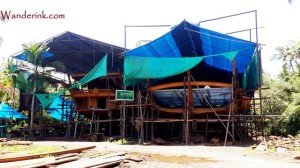
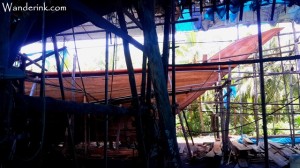
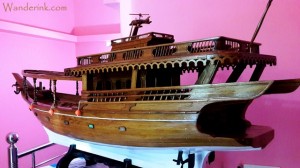
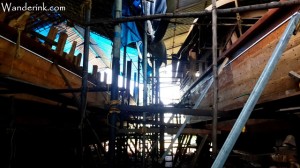
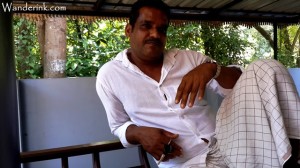
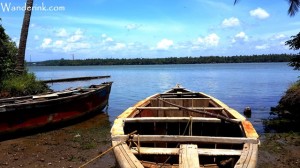
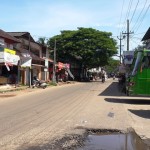









I love that scale modell. Wonder if they ever build real boats like that. The real ones look so different.
Am told they built the big – real – ones from these models. (Well, if they don’t, you can still buy these, models that is.)
Fascinating as always. The seasoning of the wood, the pungent smell of the varnish, the curving of the slabs, the final putting together of the uru, wow! I can just go on picturing. I always keep watching these docus from all over the world. Must have been a pirate in my last life 😉 Thanks for sharing.
You must have been a pirate alright…all the proximity to the fishes 🙂 But thanks and welcome.